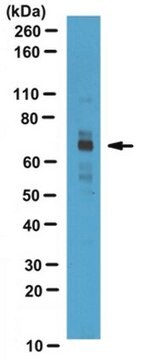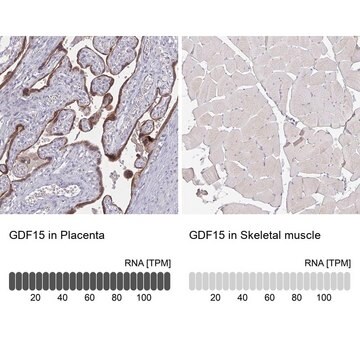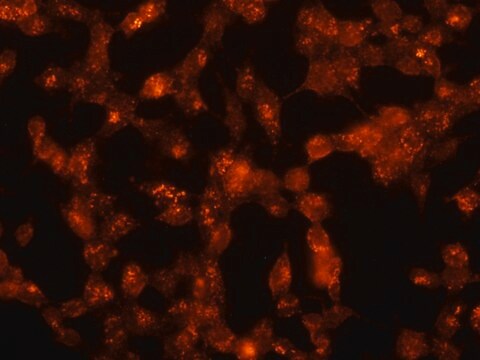17-10267
ChIPAb+ FOXA1 Antibody
from rabbit, purified by affinity chromatography
Synonym(s):
Forkhead box protein A1, Hepatocyte nuclear factor 3-alpha, HNF-3A, Transcription factor 3A, TCF-3A
Sign Into View Organizational & Contract Pricing
All Photos(4)
About This Item
UNSPSC Code:
12352203
eCl@ss:
32160702
NACRES:
NA.32
Recommended Products
biological source
rabbit
Quality Level
clone
polyclonal
purified by
affinity chromatography
species reactivity
mouse, human
manufacturer/tradename
ChIPAb+
Upstate®
technique(s)
ChIP: suitable
immunocytochemistry: suitable
western blot: suitable
NCBI accession no.
UniProt accession no.
shipped in
dry ice
Gene Information
human ... FOXA1(3169)
General description
All ChIPAb+ antibodies are individually validated for chromatin precipitation, every lot, every time. Each ChIPAb+ antibody set includes control primers (tested every lot by qPCR) to biologically validate your IP results in a locus-specific context. The qPCR protocol and primer sequences are provided, allowing researchers to validate ChIP protocols when using our antibody in their chromatin context. Each set also includes a negative control antibody to ensure specificity of the ChIP reaction.
The ChIPAb+ FOXA1 set includes the FOXA1 antibody, a Normal Rabbit IgG, and control primers which amplify a 138 bp region of ChIP Primers, Mouse Hnf4α enhancer. The FOXA1 and negative controls are supplied in a scalable "per ChIP" reaction size and can be used to functionally validate the precipitation of FOXA1-associated chromatin.
The ChIPAb+ FOXA1 set includes the FOXA1 antibody, a Normal Rabbit IgG, and control primers which amplify a 138 bp region of ChIP Primers, Mouse Hnf4α enhancer. The FOXA1 and negative controls are supplied in a scalable "per ChIP" reaction size and can be used to functionally validate the precipitation of FOXA1-associated chromatin.
HNF-3A, Hepatocyte nuclear factor 3-alpha (also called FOXA1) is member of the Forkhead family of winged-helix transcription factors. This protein family has around 50 known transcription factors and play an important role in the regulation of cell differentiation, organogenesis, and gene expression. High levels of expression of HNF-3A has been observed in tumors arising from both the prostate and breast. Here it is believed this protein interacts with the androgen receptor in prostate tumors and the estrogen receptor α in breast tumors. In the case of ERα, HNF-3A interacts with cis-regulatory regions in heterochromatin and enhances the interaction of ERα with chromatin.
Specificity
This antibody recognizes HNF-3A/FOXA1.
Immunogen
Recombinant protein corresponding to the entire protein of human FOXA1
Application
Chromatin Immunoprecipitation:
Representative lot data.
Sonicated chromatin prepared from Mouse liver tissue (1 mg tissue equivalents per IP) were subjected to chromatin immunoprecipitation using 2 µl of either normal rabbit IgG, or 2 µl Anti-FOXA1 (Part No.CS207368) and the Magna ChIP A Kit (Cat. # 17-610). Successful immunoprecipitation of FoxA1 associated DNA fragments was verified by qPCR using ChIP Primers, Mouse Hnf4α enhancer as a positive locus, and mouse Hnf4α promoter as a negative locus. (Figure 2). Data is presented as percent input of each IP sample relative to input chromatin for each amplicon and ChIP sample as indicated.
Please refer to the EZ-Magna ChIP A (Cat. # 17-408) or EZ-ChIP (Cat. # 17-371) protocol for experimental details.
Western Blotting Analysis:
Representative lot data.
Human pancreas tissue lysate was resolved by electrophoresis, transferred to PVDF membranes and probed with Anti-FOXA1 (0.5 µg/mL).
Proteins were visualized using a Donkey Anti-Rabbit IgG conjugated to HRP and chemiluminescence detection system. (Figure 3)
Arrow indicates FOXA1 (~51 kDa).
Immunocytochemistry Analysis:
Representative lot data.
Confocal fluorescent analysis of NIH/3T3 and HeLa cells using Anti-HNF-3A/FOXA1 (Red). Actin filaments have been labeled with Alexa Fluor 488 Dye-Phalloidin (Green). Nucleus is stained with DAPI (Blue). This antibody positively stains nucleus. (Figure 4)
Representative lot data.
Sonicated chromatin prepared from Mouse liver tissue (1 mg tissue equivalents per IP) were subjected to chromatin immunoprecipitation using 2 µl of either normal rabbit IgG, or 2 µl Anti-FOXA1 (Part No.CS207368) and the Magna ChIP A Kit (Cat. # 17-610). Successful immunoprecipitation of FoxA1 associated DNA fragments was verified by qPCR using ChIP Primers, Mouse Hnf4α enhancer as a positive locus, and mouse Hnf4α promoter as a negative locus. (Figure 2). Data is presented as percent input of each IP sample relative to input chromatin for each amplicon and ChIP sample as indicated.
Please refer to the EZ-Magna ChIP A (Cat. # 17-408) or EZ-ChIP (Cat. # 17-371) protocol for experimental details.
Western Blotting Analysis:
Representative lot data.
Human pancreas tissue lysate was resolved by electrophoresis, transferred to PVDF membranes and probed with Anti-FOXA1 (0.5 µg/mL).
Proteins were visualized using a Donkey Anti-Rabbit IgG conjugated to HRP and chemiluminescence detection system. (Figure 3)
Arrow indicates FOXA1 (~51 kDa).
Immunocytochemistry Analysis:
Representative lot data.
Confocal fluorescent analysis of NIH/3T3 and HeLa cells using Anti-HNF-3A/FOXA1 (Red). Actin filaments have been labeled with Alexa Fluor 488 Dye-Phalloidin (Green). Nucleus is stained with DAPI (Blue). This antibody positively stains nucleus. (Figure 4)
Research Category
Epigenetics & Nuclear Function
Epigenetics & Nuclear Function
Research Sub Category
Transcription Factors
Transcription Factors
This ChIPAb+ FOXA1 -ChIP Validated Antibody & Primer Set conveniently includes the antibody & the specific control PCR primers.
Packaging
25 assays per set. Recommended use: 2 μL of antibody per chromatin immunoprecipitation (dependent upon biological context).
Quality
Chromatin Immunoprecipitation:
Representative lot data
Sonicated chromatin prepared from Mouse liver tissue (1 mg tissue equivalents per IP) were subjected to chromatin immunoprecipitation using 2 µL of either normal rabbit IgG,or 2 µL Anti-FOXA1 and the Magna ChIP® A Kit (Cat. # 17-610). Successful immunoprecipitation of FOXA1- associated DNA fragments was verified by qPCR using ChIP Primers, Mouse Hnf4α enhancer (Figure 1).
Please refer to the EZ-Magna ChIP A (Cat. # 17-408) or EZ-ChIP (Cat. # 17-371) protocol for experimental details.
Representative lot data
Sonicated chromatin prepared from Mouse liver tissue (1 mg tissue equivalents per IP) were subjected to chromatin immunoprecipitation using 2 µL of either normal rabbit IgG,or 2 µL Anti-FOXA1 and the Magna ChIP® A Kit (Cat. # 17-610). Successful immunoprecipitation of FOXA1- associated DNA fragments was verified by qPCR using ChIP Primers, Mouse Hnf4α enhancer (Figure 1).
Please refer to the EZ-Magna ChIP A (Cat. # 17-408) or EZ-ChIP (Cat. # 17-371) protocol for experimental details.
Target description
~51 kDa
Physical form
Affinity purified
Anti-FOXA1 (Rabbit Polyclonal). One vial containing 50 µL of purified rabbit polyclonal in buffer containing 0.1 M Tris-Glycine (pH 7.4, 150 mM NaCl) with 0.05% sodium azide before the addition of glycerol to 30%. Store at -20°C.
Concentration: 0.35 mg/mL
Normal Rabbit IgG. One vial containing 125 µg Rabbit IgG in 125 µL storage buffer containing 0.05% sodium azide. Store at -20°C.
ChIP Primers, Mouse Hnf4α enhancer. One vial containing 75 μL of 5 μM of each primer specific for Mouse Hnf4α enhancer. Store at -20°C.
FOR: TTC CAG CTG CCT TTA TCT CCC TGT
REV: TCT CCA CAC ATG TCC AGC AGC CT
Concentration: 0.35 mg/mL
Normal Rabbit IgG. One vial containing 125 µg Rabbit IgG in 125 µL storage buffer containing 0.05% sodium azide. Store at -20°C.
ChIP Primers, Mouse Hnf4α enhancer. One vial containing 75 μL of 5 μM of each primer specific for Mouse Hnf4α enhancer. Store at -20°C.
FOR: TTC CAG CTG CCT TTA TCT CCC TGT
REV: TCT CCA CAC ATG TCC AGC AGC CT
Storage and Stability
Stable for 1 year at -20°C from date of receipt. Handling Recommendations: Upon first thaw, and prior to removing the cap, centrifuge the vial and gently mix the solution. Aliquot into microcentrifuge tubes and store at -20°C. Avoid repeated freeze/thaw cycles, which may damage IgG and affect product performance.
Note: Variability in freezer temperatures below -20°C may cause glycerol containing solutions to become frozen during storage.
Note: Variability in freezer temperatures below -20°C may cause glycerol containing solutions to become frozen during storage.
Analysis Note
Control
Includes normal rabbit IgG and primers specific for Mouse Hnf4α enhancer.
Includes normal rabbit IgG and primers specific for Mouse Hnf4α enhancer.
Other Notes
Concentration: Please refer to the Certificate of Analysis for the lot-specific concentration.
Legal Information
MAGNA CHIP is a registered trademark of Merck KGaA, Darmstadt, Germany
UPSTATE is a registered trademark of Merck KGaA, Darmstadt, Germany
Disclaimer
Unless otherwise stated in our catalog or other company documentation accompanying the product(s), our products are intended for research use only and are not to be used for any other purpose, which includes but is not limited to, unauthorized commercial uses, in vitro diagnostic uses, ex vivo or in vivo therapeutic uses or any type of consumption or application to humans or animals.
Storage Class Code
10 - Combustible liquids
Certificates of Analysis (COA)
Search for Certificates of Analysis (COA) by entering the products Lot/Batch Number. Lot and Batch Numbers can be found on a product’s label following the words ‘Lot’ or ‘Batch’.
Already Own This Product?
Find documentation for the products that you have recently purchased in the Document Library.
Parisa Mazrooei et al.
Cancer cell, 36(6), 674-689 (2019-11-19)
Thousands of noncoding somatic single-nucleotide variants (SNVs) of unknown function are reported in tumors. Partitioning the genome according to cistromes reveals the enrichment of somatic SNVs in prostate tumors as opposed to adjacent normal tissue cistromes of master transcription regulators
Our team of scientists has experience in all areas of research including Life Science, Material Science, Chemical Synthesis, Chromatography, Analytical and many others.
Contact Technical Service






